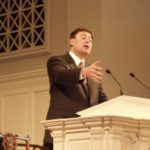 EXPOSITORY PREACHING IS CENTRAL TO GOD’S PLAN FOR BUILDING HEALTHY CHURCHES. By Dr. Mark Dever (original source here)
EXPOSITORY PREACHING IS CENTRAL TO GOD’S PLAN FOR BUILDING HEALTHY CHURCHES. By Dr. Mark Dever (original source here)
This sermon transcript originally appeared in The Southern Baptist Journal of Theology, Volume 3, issue 2 in the summer of 1999.
In my study, I have shelves and stacks of books that deal with the topic: What makes a good church? The answers range from friendliness to financial planning to being sensitive to visitors to vibrant music to pleasant surroundings to pristine bathrooms to plentiful parking to exciting children’s programs to elaborate Sunday School options.
You need to know the marks of a healthy church, especially if you are a visitor looking for a church. Even those who are members need to consider the marks of a good church, for we live in a transient age. Regardless of how happy you may be living here, you, too, might move, and perhaps sooner than you think. You need to know what your goal is in looking for a church, and you need to identify the right foundation. Even if you stay, you need to know what makes a good church. For you will have a role in building and shaping it. “Experts” will tell you it is everything from how religion-free your language is to how invisible your membership requirements are. Are secure nurseries and sparkling bathrooms really the way to church growth and church health?
EXPOSITIONAL PREACHING
The most important distinguishing mark of a healthy church is expositional preaching. It is the most important because careful and thorough preaching of God’s Word will bring many other blessings to a church. Without expository preaching, other signs of health may be accidental. They may be discarded or distorted all too easily because they did not spring from the Word, nor are they continually being reshaped and refreshed by it. But if you establish the priority of the Word, then you have in place the single most important aspect of the church’s life. With the Word established, a church may experience growing health; without the Word, a church’s health is imperiled.
What is this essential mark that is called “expositional preaching”? Expository preaching is usually contrasted to “topical preaching,” which is the kind of preaching in this sermon, when I take a subject and talk about it, rather than a text from the Bible and spend the whole sermon explaining it.
The topical sermon begins with a particular topic on which the preacher wants to preach and then assembles truth from various texts of the Bible. Stories and anecdotes are combined, and all are woven together around one theme rather than around one text of Scripture.
A topical sermon may also be expositional, insofar as it uses texts carefully and well, but the point of the sermon was already determined before the preparation for the sermon had begun. I already knew what I wanted to say when I set out to prepare this sermon, as opposed to what is usually the case when I preach expositionally. In the latter instance I may be surprised by the message of the text.
If expositional preaching is so important, it needs to be defined. Expositional preaching is not simply producing a verse by verse commentary from the pulpit. Rather, expositional preaching is that preaching which takes for the point of a sermon the point of a particular passage of Scripture. This is clearly not what I am doing in this sermon. But it is what I have intended to do every other time I have entered the pulpit to preach.
Expositional preaching is preaching in service to the Word. It presumes a belief in the authority of Scripture, but it is something more: A commitment to expositional preaching is a commitment to hear God’s Word.
Even as Old Testament prophets and New Testament apostles were given not just a commission to go and speak, but a particular message to deliver, so Christian preachers today have authority to speak from God only so long as they speak His words. Preachers are not merely commanded to preach, but they are commanded specifically to preach the Word.
 Transcript of The Dividing Line. March 6, 2018 at the 9:00 minute mark, Dr. James White.
Transcript of The Dividing Line. March 6, 2018 at the 9:00 minute mark, Dr. James White.
